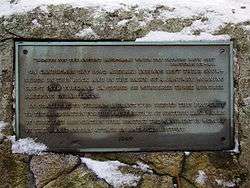Raid on York (1692)
| Raid on York (1692) | |||||||
|---|---|---|---|---|---|---|---|
| Part of King William's War | |||||||
 Memorial plaque in York, ME | |||||||
| |||||||
| Belligerents | |||||||
|
Acadia Abenaki |
| ||||||
| Commanders and leaders | |||||||
|
Chief Madockawando, Father Louis-Pierre Thury[1] Sr. de Portneuf[2] | Preble, John Harmon,[3] Alcock, and Norton | ||||||
| Strength | |||||||
| 200-300 Abenaki and Canadiens | |||||||
| Casualties and losses | |||||||
| unknown | 75 killed and 100 prisoners[4] Abenaquis reported killing or capturing 187 people[5] | ||||||
The Raid on York (also known as the Candlemas Massacre) took place on 24 January 1692[6][7] during King William's War, when Chief Madockawando and Father Louis-Pierre Thury led 200-300 natives into the town of York (then in the District of Maine and part of the Province of Massachusetts Bay, now in the state of Maine), killing about 100 of the English settlers and burning down buildings, taking another estimated 80 villagers hostage. The villagers were forced to walk to Canada, New France,[1] where they were ransomed by Capt. John Alden Jr. of Boston (son of John Alden and Priscilla Mullins of the Plymouth Colony). One of those taken Captive was a young Jeremiah Moulton, who would later gain notoriety during the Father Rale's War.[8]
Capt. Floyd wrote that "the houses are all burned and rifled except the half dozen or thereabout"...later in the same letter he adds: "there is about seventeen or eighteen houses burned".[9] Forty-eight people were buried by Capt. Floyd, and the remaining number were young children whose names never appeared on the existing town records.
Amongst those killed was Reverend Shubael Dummer, the Congregational church minister; Dummer was shot at his own front door, while Dummer's wife, Lydia and their son, were carried away captive where "through snows and hardships among those dragons of the desert she also quickly died"; nothing further was heard of the boy.[10] The Indians set fire to all undefended houses on the north side of the York River, the principal route for trade and around which the town had grown. After the settlement was reduced to ashes, however, it was rebuilt on higher ground at what is today York Village.
Capt. John Flood, who had come with the militia from Portsmouth, found on his arrival that "the greatest part of the whole town was burned and robbed," with nearly 50 killed and another 100 captured. He reported that Rev. Dummer was "barbarously murthered, stript naked, cut and mangled by these sons of Beliall."[11]
Today the event is commemorated annually in York, with historical re-enactments and lectures, events presented by the Old York Historical Society and sponsored in part by the Maine Humanities Council.
There is a memorial plaque in York on a large stone where, according to the plaque, Abenaki Indians left their snowshoes before creeping into York and attacking the settlers.
See also
References
- 1 2 York, Maine Settlers Killed by Abnaki Chief Madockawando 25 January 1692, retrieved 2 January 2013
- ↑ Villebon, p. 36, March 18
- ↑ Harmon Genealogy )
- ↑ William Williamson. The History of the State of Maine. p. 629
- ↑ Villebon, p. 36, March 18
- ↑ Baker Emerson W. and James Kences, Maine, Indian Land Speculation, and the Essex County Witchcraft Outbreak of 1692 Maine History, volume 40, number 3, Fall 2001 (pp. 159-189)]
- ↑ Sewall, Samuel, The Diary of Samuel Sewall: Vol. 1, 1674-1708, Farrar, Straus & Girous: New York, 1973, p. 287, note: This is the date of the Old Style, Julian Calendar. The date New Style, Gregorian is 3 Feb. Candlemas is traditionally celebrated by the Church of England on 23 January or the Sunday between 18 and 24 January (In the Catholic Church day is marked on January 23, forty days after Christmas). Two days after the attack Samuel Sewall recorded in his diary: "Tuesday, Jan. 26, 1691/2 [New Style February 5], ... This day...news was brought of an Attack made by the Indians on York."
- ↑ Stewart, Alice R. (1974). "Moulton, Jeremiah". In Halpenny, Francess G. Dictionary of Canadian Biography. III (1741–1770) (online ed.). University of Toronto Press.
- ↑ Banks, Charles Edward, History of York, Maine, successively known as Bristol (1632), Agamentious (1641), Gorgeana (1642), and York (1652). With contributions on topography and land titles by Angevine W. Gowen. Sketches by the author. (Baltimore, Regional Publishing Company, 1967 reprint of first edition: Charles E Banks, Boston, 1931 [Vol.1]... page 295
- ↑ Dummer, Michael (June 2005). The Family of Dummer; chapter 5 "Richard and Early Days in New England" (7th ed.). p. 26.
- ↑ Norton, Mary Beth (18 December 2007). In the Devil's Snare. Knopf Doubleday Publishing Group. Retrieved 2 January 2013.
Additional reading
- Raid on York - Residents
- History of York, Maine (1886)
- Clayton, W. W. "History of York County, Maine. With illustrations and biographical sketches of its prominent men and pioneers", 1888. p. 51